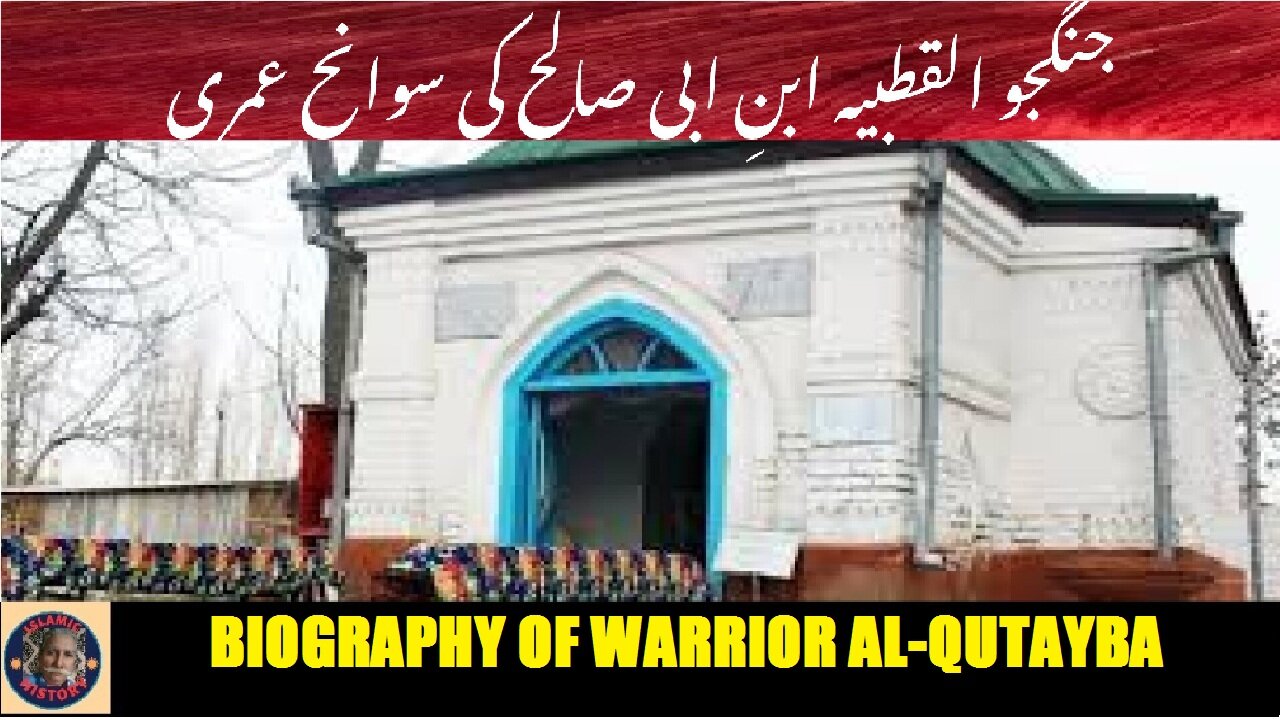Premium Only Content

Biography of Warrior Al-Qutayba Ibn Abi Salih جنگجو القطیبہ ابن ابی صالح کی سوانح عمری
@islamichistory813 #HistoricalFigures #MilitaryLeadership #AlQutayba
Biography of Warrior Al-Qutayba Ibn Abi Salih
Dekhti Aankhooon aur sountay kaanoon ko Asslamoalaikum, sisters, brothers friends and elders, In this Islamic Warrior Leaders informative videos, we present the biography of Al-Qutayba Ibn Abi Salih, a distinguished warrior whose life was marked by valor and leadership. We will describe his significant military achievements, the challenges he faced, and his role in the expansion of the Islamic empire. Get to know the story of a man whose legacy continues to inspire generations.
Abu Hafs Qutayba ibn Abi Salih Muslim ibn Amr al-Bahili was an Arab commander of the Umayyad Caliphate who became governor of Khurasan and distinguished himself in the conquest of Transoxiana during the reign of al-Walid I (705–715). A capable soldier and administrator, he consolidated Muslim rule in the area and expanded the Caliphate's border to include most of Transoxiana. From 705 to c.?710, he consolidated Muslim control over the native principalities of Tokharistan and conquered the principality of Bukhara, while in 710–712 he conquered Khwarizm and completed the conquest of Sogdiana with the capture of Samarkand. The latter opened the road to the Jaxartes valley, and during the last years of his life Qutayba led annual campaigns there, extending Muslim control up to the Fergana Valley and parts of Chinese Turkestan.
To increase his strained manpower, Qutayba initiated the wide-scale levy of native Khurasani and Transoxianian soldiers who fought alongside the Arab Muslim troops. Following Walid's death, Qutayba, insecure of his position under the new regime, rebelled but failed to secure the support of his army, and was killed. Most of his conquests in Transoxiana were lost in the years after his death; only in the 740s was the Muslim position restored to the line reached by Qutayba, and only after the Battle of Talas in 751 did the region come solidly under Muslim control.
Qutayba was born in 669 CE in Basra, to an influential family of the Bahila tribe.[1] His father, Muslim ibn ?Amr, had enjoyed the favour of the Umayyads, but fought for their enemy Mus'ab ibn al-Zubayr at the Battle of Maskin during the close of the Second Muslim Civil War. He was killed in the fighting, but while he lay wounded he obtained assurances of safety for Qutayba from Caliph Abd al-Malik ibn Marwan. Qutayba rose at first as the protege of Anbasa ibn Sa'id, but was noticed by the powerful governor of Iraq and the East, al-Hajjaj ibn Yusuf, during the suppression of the revolt of Abd al-Rahman ibn Muhammad ibn al-Ash'ath in 700/701. Under al-Hajjaj's patronage, he took Rayy from the rebel Umar ibn Abi'l-Salt in 701, and became the city's governor.
Then, in late 704 or early 705, Abd al-Malik appointed Qutayba as governor of Khurasan in succession to al-Mufaddal ibn al-Muhallab. The choice of Qutayba, who hailed from the relatively weak Bahila tribe, was intended by al-Hajjaj to heal the destructive feud between the South Arab or "Yemeni" (Azd and Rabi'ah) and North Arab (Qaysi) tribal confederations in Khurasan by providing a governor who did not belong to either. The Bahila were neutral between the two groups, but generally allied themselves to the Qays, thus furthering al-Hajjaj's policy of emasculating Azdi power, which had been dominant in Khurasan during the governorship of al-Mufaddal's brother, Yazid ibn al-Muhallab. Furthermore, as Qutayba lacked a strong tribal base of his own, he could be expected to remain firmly attached to his patron.
Qutayba would spend the next ten years of his life in Central Asia, consolidating and expanding Muslim rule there. In this endeavour, both his military and diplomatic and organisational abilities came him in good stead; most importantly, he was able to enlist the support of the local Iranian population and the powerful dihqan (the Iranian "gentry") class.
So sisters brothers friends and elders, tomorow we are going to described How was Qutayba suppression of the rebellion in Lower Tokharistan. Allah hafiz
==============================
-
 6:58
6:58
ISLAMIC HISTORY
1 day agoBiography of Islamic Scholar Abu Sahl al-Quhi اسلامی اسکالر ابو سہل القحی کی سوانح عمری۔
9 -
 28:24
28:24
Michael Franzese
1 hour agoHow Jewish Mafia Influenced American Organized Crime
2802 -
 LIVE
LIVE
Dr Disrespect
5 hours ago🔴LIVE - DR DISRESPECT - BABY STEPS - THE VERY VERY LAST CHAPTER
2,082 watching -
 LIVE
LIVE
StoneMountain64
3 hours agoBLACK OPS 7 Unlocking Weapons and Overclocks (Mouse and Keyboard Player)
173 watching -
 LIVE
LIVE
ahdedazs
3 hours ago $0.03 earnedBlack Ops 7 EARLY ACCESS BETA! Second Stream on RUMBLE! *NEW CREATOR*
58 watching -
 LIVE
LIVE
LadyDesireeMusic
3 hours ago $0.47 earnedLive Piano 10-3-25
171 watching -
 54:08
54:08
vivafrei
1 hour agoLive With Dinesh D'Souza-The Dragons Prophecy
38.1K18 -
 3:20:13
3:20:13
Barry Cunningham
4 hours agoBREAKING NEWS: KAROLINE LEAVITT HOSTS SURPRISE WHITE HOUSE PRESS CONFERENCE!
46.5K29 -
 12:15
12:15
Dr. Nick Zyrowski
4 days agoSTOP Believing These Fasting Lies That Keep You Sick
7.3K1 -
 2:01:12
2:01:12
The Culture War with Tim Pool
6 hours agoNigeria's Christian Genocide, Media Ignoring Atrocities | The Culture War Podcast
154K83
